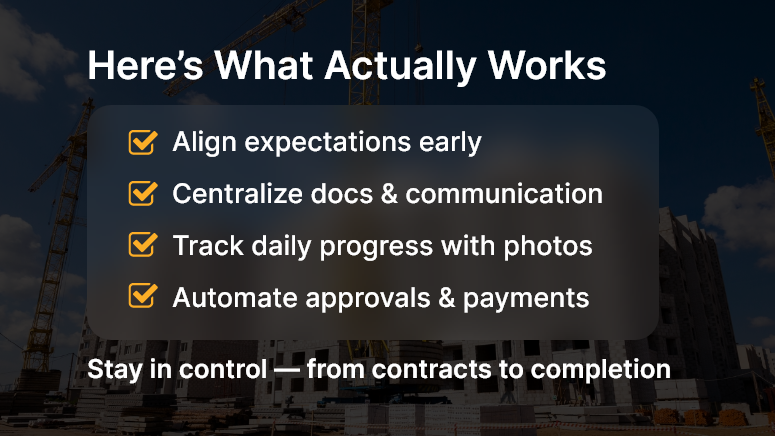Managing contractors and subcontractors is like conducting an orchestra — except your performers are often late, under-informed, or working off different sheet music.
In fact, according to a KPMG study, over 70% of construction projects face schedule overruns — with subcontractor misalignment a top cause.
In today’s fast-moving environment, poor contractor coordination isn’t just inefficient — it’s expensive and risky.
This blog explores proven strategies, tools, and frameworks to help you manage contractors and subcontractors more effectively. You’ll learn best practices, industry insights, and how platforms like OConstruction give you visibility, control, and peace of mind.

Why Contractor/Subcontractor Management Matters More Than Ever
Whether you’re building a commercial skyscraper or a residential complex, success hinges on how well your contractor and subcontractor ecosystem performs.
Common Real-World Challenges:
- Missed Deadlines: A plumber delayed by 3 days can hold up painters and inspectors for a week.
- Disjointed Communication: Contractors may not report issues promptly — causing reactive, not proactive, problem-solving.
- Scope Creep & Budget Overruns: Without clear documentation and oversight, minor changes spiral into major cost blowouts.
Who Benefits the Most:
- Project Managers needing tighter timelines and budget adherence.
- General Contractors coordinating multiple trades under pressure.
- Owners and Developers demand faster ROI and fewer surprises.
The bottom line? Without streamlined subcontractor management, you’re gambling with productivity, safety, and profitability.
Actionable Best Practices for Managing Contractors & Subcontractors
1. Set Crystal-Clear Expectations
Before the project begins, define roles, responsibilities, deliverables, and timelines. Use digital contracts and SOWs (Statements of Work) stored centrally.
- Align everyone on project milestones and dependencies.
- Set quality benchmarks and communication cadence.
- Track deliverables using cloud-based dashboards.
2. Centralize Documentation and Communication
Use a unified platform like OConstruction to store:
- Contracts
- Insurance documents
- Work orders
- RFIs (Requests for Information)
With a single source of truth, contractors can access the info they need — fast, reducing mistakes and repetitive back-and-forth.
3. Real-Time Progress Tracking & Daily Logs
Track work done daily — with photos, notes, and timestamps.
- Identify bottlenecks early.
- Validate work before issuing payments.
- Improve transparency across stakeholders.
Bonus: Use mobile inspection tools to upload site photos directly to the dashboard.
4. Establish Accountability with Audit Trails
With time-stamped updates and user logs:
- You can trace who approved what and when.
- Avoid finger-pointing during disputes.
- Strengthen compliance reporting for audits and safety checks.
5. Automate Subcontractor Onboarding
- Digitize contract signing and orientation paperwork.
- Use task checklists to guide subcontractors through safety briefings.
- Sync onboarding data to project timelines automatically.
6. Build In Checkpoints & Sign-Offs
- Use milestone-based tracking.
- Require supervisor sign-offs before new work begins.
- Schedule automated alerts for inspection readiness or punch lists.
7. Improve Payment Timelines with Verification Workflows
- Link invoices to actual work logs.
- Use digital signatures and photo documentation for faster approval.
- Set alerts for overdue tasks or unsigned dockets.
Pro tip: OConstruction users reduce payment approval cycles by up to 40% using integrated workflows.
Customer Story
For example, NextBuild Developers, a mid-sized commercial construction firm, used OConstruction’s subcontractor tracking tools to streamline progress reporting across 20+ subcontractors.
Result?
- Reduced project delays by 22%
- Improved invoice verification speed by 40%
- Cut back-and-forth calls/emails by 60%
Here’s how: By centralizing communication, automating check-ins, and using mobile uploads for daily logs, their team stayed aligned across shifting deadlines.
Key Takeaways & Final Thoughts
Strong subcontractor management isn’t just good practice — it’s a strategic advantage.
When you align expectations, digitize documentation, and establish real-time visibility, you:
- Reduce confusion and delays
- Improve accountability and trust
- Streamline payment cycles and inspections
Platforms like OConstruction help you turn subcontractor chaos into a coordinated operation.
If you’re still managing subs with spreadsheets, emails, and phone calls — it’s time to rethink.
Managing contractors and subcontractors effectively drives profits, cuts costs, and protects your reputation.


